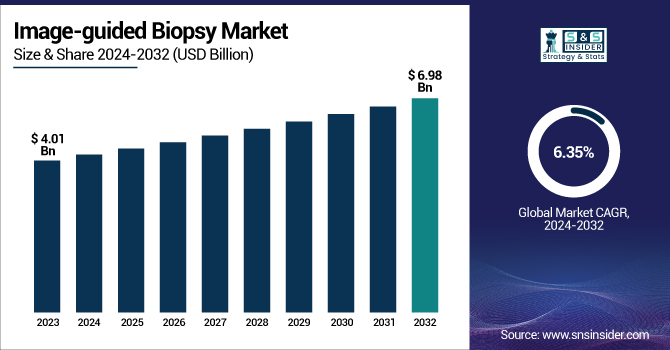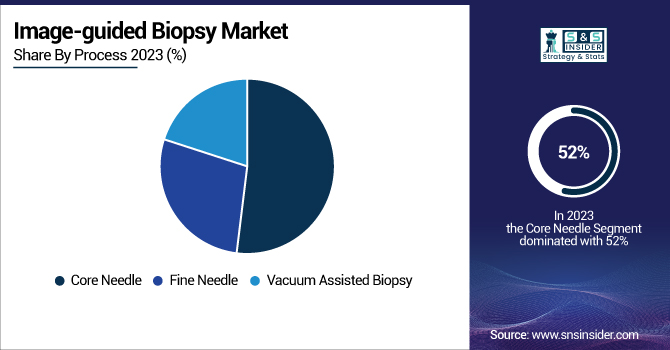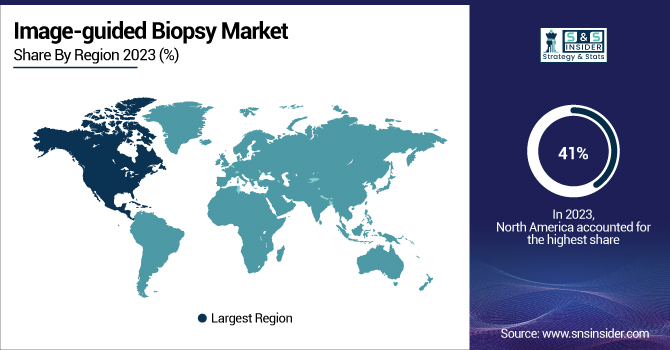Image-guided Biopsy Market Report Scope & Overview
The Image-guided Biopsy Market size was USD 4.01 billion in 2023 and is expected to reach USD 6.98 billion by 2032 and grow at a CAGR of 6.35% over the forecast period of 2024-2032.

To Get more information on Image-guided Biopsy Market - Request Free Sample Report
This report provides comprehensive insights into the Image-guided Biopsy Market, highlighting key trends such as the rising volume of biopsy procedures due to increasing cancer prevalence and advancements in imagmagneting technologies. It examines the adoption of AI and robotics in biopsy guidance, along with the growing preference for outpatient and ambulatory surgical centers. The study analyzes reimbursement trends, healthcare spending, and the economic impact of image-guided biopsies compared to conventional techniques. Additionally, it covers technological adoption rates across MRI, CT, and ultrasound-guided procedures, along with regulatory approvals and clinical trials. The report also explores patient outcomes, demonstrating improved accuracy and reduced complications. Furthermore, it provides insights into the increasing integration of AI-assisted diagnostic imaging and robotic biopsy systems.
North America dominated the image-guided biopsy market in the U.S., accounting for 71% of the overall share, owing to advanced healthcare infrastructure, high adoption of sophisticated imaging technologies, and presence of key players in the region, as per the earlier aspect. Not only does this country have a well-established reimbursement infrastructure, which encourages the hospitals and diagnostic centers to embrace advanced biopsy procedures. In addition, government initiation in funding towards cancer research & advancement of imaging mechanisms in coordination with fast implementation of AI in performing the biopsy processes accentuates the market expansion. Minimally invasive procedure preference and the presence of extensive specialty clinics in the region have enabled the U.S. to remain on the top.
Market Dynamics
Drivers
-
Rising cancer prevalence and increasing demand for minimally invasive diagnostic techniques propel the image-guided biopsy market growth.
The growing global burden of cancer, particularly breast, lung, and prostate cancer, is significantly driving the demand for image-guided biopsy procedures. According to the World Health Organization (WHO), cancer cases are expected to rise by over 50% by 2040, increasing the need for early and accurate diagnostic techniques. Image-guided biopsies provide higher precision, minimal invasiveness, and reduced recovery time compared to conventional surgical biopsy methods, making them a preferred choice among healthcare providers. Additionally, technological advancements such as AI-assisted imaging and robotic-guided biopsy systems are enhancing accuracy and efficiency, further fueling market growth. Governments and healthcare agencies are also expanding reimbursement policies to support the adoption of advanced diagnostic imaging techniques, further bolstering market expansion. The shift towards outpatient and ambulatory surgical centers further supports the increased adoption of these procedures.
Restraint:
-
High Costs associated with image-guided biopsy procedures and limited access to advanced imaging technologies in developing regions hinder market growth.
One of the major restraints affecting the growth of the image-guided biopsy market is the high cost associated with advanced imaging systems such as MRI, CT, and ultrasound-guided biopsy procedures. The initial investment in imaging infrastructure, coupled with the expenses of trained radiologists and interventional specialists, significantly increases the overall cost of the procedure. This poses a major challenge, particularly in low- and middle-income countries where access to high-end imaging technology remains limited. Additionally, reimbursement policies in many regions do not fully cover the costs of advanced diagnostic techniques, leading to financial constraints for both healthcare providers and patients. The lack of skilled professionals trained in handling sophisticated imaging technologies further limits widespread adoption, restricting market growth in certain regions, particularly in rural and underdeveloped healthcare systems.
Opportunity:
-
Technological advancements in AI-driven imaging and robotic-assisted biopsy procedures create new growth opportunities in the market.
The integration of artificial intelligence (AI) and robotics in biopsy procedures is opening new avenues for market expansion. AI-driven imaging analysis enhances the accuracy and speed of tumor detection, reducing the chances of false negatives and improving overall diagnostic efficiency. Robot-assisted biopsy procedures provide superior precision, reducing human error and improving patient outcomes. Major players are increasingly investing in AI-powered imaging solutions that assist in real-time decision-making and automated tumor segmentation. Additionally, the rising adoption of telemedicine and remote diagnostics is further expanding access to image-guided biopsy procedures, particularly in underserved regions. The growing collaboration between healthcare institutions and technology companies to develop next-generation biopsy solutions is expected to drive market growth, offering significant opportunities for innovation and investment.
Challenge:
-
Regulatory approvals and stringent compliance requirements pose challenges to the commercialization of image-guided biopsy devices and technologies.
The image-guided biopsy market faces challenges due to stringent regulatory approval processes and compliance requirements across different regions. Medical imaging devices and biopsy systems must undergo rigorous clinical trials and obtain approvals from regulatory bodies such as the U.S. FDA, the European Medicines Agency (EMA), and other global health authorities. The long approval timelines and high costs associated with regulatory compliance often delay the commercialization of innovative biopsy technologies. Additionally, variations in regulatory frameworks across different countries create complexities for manufacturers seeking global market expansion. Ensuring compliance with data security and patient safety standards, particularly in AI-integrated biopsy systems, further adds to the challenges. Companies must invest significant time and resources in meeting these regulatory requirements, which can slow down market entry and limit the widespread adoption of new biopsy solutions.
Segmentation Analysis
By Process
The core needle held the largest market share, around 52%, in 2023. It is extensively used for diagnosing cancer, including breast cancer, prostate cancer, and lung cancer. CNB strikes a good balance between accuracy and limits on invasiveness, obtaining bigger tissue samples than fine needle aspiration (FNA) but less invasive than surgical biopsies. Especially for breast cancer diagnosis, ASBrS guidelines recommended the use of CNB as the standard diagnostic method. Image-guided techniques, including ultrasound and MRI-assisted core needle biopsy, have played a vital role in limiting complications and increasing accuracy. A growing trend of moving away from inpatient and towards outpatient and ambulatory settings, when paired with beneficial reimbursement policies, has driven the segment’s dominance. In addition, CNB has high-reliability histopathological results at a low cost, establishing it as a leader in the market.

By Image Guided Technology
Ultrasound-guided biopsy held the largest market share, around 38%, in 2023. It is owing to its increasingly prevalent use in combination with that in combination with low economic cost, and image-guided biopsy in ultrasound is seen as the preferred method with real-time imaging capabilities. Owing to widespread use in the detection of breast, thyroid gland, liver, and prostate cancers and other soft tissue disorders, this modality is extensively adopted worldwide. Ultrasound provides a non-invasive and radiation-free procedure compared with MRI and CT-enhanced procedures, making it safer and more ideal for repeated use. It is also much less expensive compared to MRI and CT, driving growing implementation — especially in developing regions with limited healthcare infrastructure. Ultrasound improves diagnostic accuracy, reduces the risk of complications, and increases precision in needle placement by providing real-time imaging capabilities.
By End User
Hospitals and clinics held the largest market share at around 38% in 2023. This is owing to their advanced imaging infrastructure, large patient inflow, and availability of specialized healthcare professionals. These centers provide a full spectrum of diagnostic and therapeutic services, and they are the go-to for complicated biopsy biopsies that need MRI, CT, or ultrasound guidance. Higher reimbursement rates and more government funding mean that hospitals have the resources to invest in the latest and greatest biopsy technologies. Moreover, the growing incidence of cancer along with chronic diseases is also catalyzing demand for biopsy as it is performed in hospital settings to provide integrated patient care led by the multidisciplinary team. The proficiency of on-site expert support helps the image-guided biopsy be more accurate and successful, a role that includes expert radiologists, oncologists, and interventional specialists. Thus, hospitals and clinics remain the primary driver of the market, owing to better capabilities, experience level, and access to patients.
Regional Analysis
North America held the largest market share at around 41% in 2023. This is owing to well-established healthcare infrastructure, the presence of major market players in the region, and high adoption of advanced imaging technologies that are driving growth of the image-guided biopsy market in the region. The region is home to major government investments for cancer research and research in diagnostic imaging, including multiple programs funded by the National Cancer Institute (NCI). Rising cancer cases, especially of breast, lung, and prostate cancers, are fuelling the need for accurate biopsy methods. Further, the U.S. and Canada provide extensive health coverage that has opted to reimburse for biopsy techniques, which drove hospitals and diagnostic centers to adopt advanced biopsy techniques. The technological advancement of AI-assisted imaging, robotic biopsy systems, and minimally invasive biopsy techniques has driven the global biopsy market. In addition, with a solid regulatory system and early FDA clearances in well-defined clinical trial programs, North America has strengthened its dominance in the worldwide image-guided biopsy market.
Europe held a significant market share in 2023. This is due to more advanced health care systems, broad acceptance of precision diagnostics, and well-established government support for cancer screening programs. In countries like Germany, France, and the U.K., the favorable reimbursement policies of the reimbursement agencies over the recent years have encouraged hospitals and diagnostic centers to invest in high-end imaging technologies in their clinic setups since the national cancer control programs have advocated the urgent requirement for state-of-the-art imaging technologies. Europe leads the way in the world of medical research, with leading universities and research institutes (such as the University of Cambridge) paving the way to innovations in AI-assisted imaging and the use of minimally invasive biopsies. Moreover, the region's leading market share can be attributed to the presence of key market players and early approvals from the European Medicines Agency (EMA).

Get Customized Report as per Your Business Requirement - Enquiry Now
Key Players
-
Ethicon Endo-Surgery: (ENDOPOUCH Retrieval Pouch, ENDOLOOP Ligature)
-
Intact Medical Corporation: (Intact Breast Lesion Excision System, Intact Excise)
-
Galini SRL: (Galini Biopsy Needle, Galini Coaxial Needle)
-
Hologic Inc.: (Brevera Breast Biopsy System, Eviva Breast Biopsy System)
-
Leica Biosystems Nussloch GmbH: (Mammotome Elite Biopsy System, Mammotome Revolve Biopsy System)
-
C. R. Bard, Inc.: (Mission Biopsy Instrument, Vacora Biopsy System)
-
Becton, Dickinson and Company: (BD Vacutainer Biopsy Needle, BD Temno Biopsy Device)
-
Argon Medical Devices: (SuperCore Biopsy Instrument, Tru-Core II Biopsy Needle)
-
Cook Medical Incorporated: Quick-Core Biopsy Needle, EchoTip ProCore Endobronchial Ultrasound Needle)
-
Encapsule Medical Devices LLC (Encapsule Biopsy System, Encapsule Core Biopsy Needle)
-
Siemens Healthineers: (ACUSON S2000 Ultrasound System, Mammomat Inspiration Biopsy Unit)
-
Philips Healthcare: Affiniti 70 Ultrasound System, MicroDose SI Mammography System)
-
GE Healthcare: (Invenia ABUS, Senographe Pristina)
-
Canon Medical Systems (Aplio i-series Ultrasound, Celesteion PET/CT System)
-
Fujifilm Holdings Corporation (ARIETTA 850 Ultrasound, ASPIRE Cristalle Mammography System)
-
Carestream Health: (DRX-Ascend System, DRX-Revolution Mobile X-ray System)
-
Hitachi Medical Systems: (ARIETTA 70 Ultrasound, Supria CT Scanner)
-
Medtronic: (O-arm Surgical Imaging System, StealthStation Surgical Navigation)
-
Boston Scientific: (LithoVue Single-Use Digital Flexible Ureteroscope, SpyGlass DS Direct Visualization System)
-
Stryker Corporation (NAV3i Surgical Navigation Platform, iSuite Integrated Operating Room)
Recent Development:
-
In March 2024, Medtronic introduced the Fusion Biopsy System, a robotic-assisted platform that enhances prostate biopsy precision by incorporating advanced imaging and AI technology.
-
In February 2024, Hologic launched the Selenia Dimensions 3D Mammography System, designed to enhance breast cancer detection with advanced biopsy technology and improved imaging capabilities.
-
In September 2024, Koelis collaborated with DeepHealth to integrate AI-powered prostate MRI software into its Trinity 3D Ultrasound Platform, streamlining prostate MRI analysis and enabling seamless MRI-US fusion for biopsy and treatment.
| Report Attributes | Details |
|---|---|
| Market Size in 2023 | USD4.01 Billion |
| Market Size by 2032 | USD 6.98 Billion |
| CAGR | CAGR of6.35 % From 2024 to 2032 |
| Base Year | 2023 |
| Forecast Period | 2024-2032 |
| Historical Data | 2020-2022 |
| Report Scope & Coverage | Market Size, Segments Analysis, Competitive Landscape, Regional Analysis, DROC & SWOT Analysis, Forecast Outlook |
| Key Segments | • By Process (Vacuum, Assisted Biopsy, Core Needle, Fine Needle) • By Technology (MRI Guided, Ultrasound Guided, Mammography, CT, X-Ray) • By End User (Hospitals And Clinics, Ambulatory Surgical Centes, Research and Academic Institutes) |
| Regional Analysis/Coverage | North America (US, Canada, Mexico), Europe (Eastern Europe [Poland, Romania, Hungary, Turkey, Rest of Eastern Europe] Western Europe] Germany, France, UK, Italy, Spain, Netherlands, Switzerland, Austria, Rest of Western Europe]), Asia Pacific (China, India, Japan, South Korea, Vietnam, Singapore, Australia, Rest of Asia Pacific), Middle East & Africa (Middle East [UAE, Egypt, Saudi Arabia, Qatar, Rest of Middle East], Africa [Nigeria, South Africa, Rest of Africa], Latin America (Brazil, Argentina, Colombia, Rest of Latin America) |
| Company Profiles | Ethicon Endo-Surgery, Intact Medical Corporation, Galini SRL, Hologic Inc., Leica Biosystems Nussloch GmbH, C. R. Bard, Inc., Becton, Dickinson and Company, Argon Medical Devices, Cook Medical Incorporated, Encapsule Medical Devices LLC, Siemens Healthineers, Philips Healthcare, GE Healthcare, Canon Medical Systems, Fujifilm Holdings Corporation, Carestream Health, Hitachi Medical Systems, Medtronic, Boston Scientific, Stryker Corporation. |

